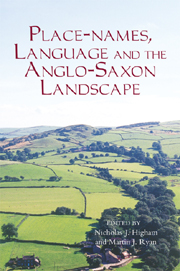Book contents
- Frontmatter
- Contents
- List of Illustrations
- Acknowledgements
- List of Contributors
- Abbreviations
- 1 Place-Names, Language and the Anglo-Saxon Landscape: An Introduction
- 2 The Landscape of Place-Name Studies
- 3 Place-Names as Travellers' Landmarks
- 4 Light thrown by Scandinavian Place-Names on the Anglo-Saxon Landscape
- 5 Language and the Anglo-Saxon Landscape: Towards an Archaeological Interpretation of Place-Names in Wiltshire
- 6 Hunting the Vikings in South Cumbria from Ambleside to Haverbrack
- 7 Viking-Age Amounderness: A Reconsideration
- 8 The Woodland Landscape of Early Medieval England
- 9 The Pre-Conquest Lands and Parish of Crediton Minster, Devon
- 10 Rewriting the Bounds: Pershore's Powick and Leigh
- 11 That ‘Dreary Old Question’: The Hide in Early Anglo-Saxon England
- 12 Boroughs and Socio-Political Reconstruction in Late Anglo-Saxon England
- Index
3 - Place-Names as Travellers' Landmarks
Published online by Cambridge University Press: 05 February 2013
- Frontmatter
- Contents
- List of Illustrations
- Acknowledgements
- List of Contributors
- Abbreviations
- 1 Place-Names, Language and the Anglo-Saxon Landscape: An Introduction
- 2 The Landscape of Place-Name Studies
- 3 Place-Names as Travellers' Landmarks
- 4 Light thrown by Scandinavian Place-Names on the Anglo-Saxon Landscape
- 5 Language and the Anglo-Saxon Landscape: Towards an Archaeological Interpretation of Place-Names in Wiltshire
- 6 Hunting the Vikings in South Cumbria from Ambleside to Haverbrack
- 7 Viking-Age Amounderness: A Reconsideration
- 8 The Woodland Landscape of Early Medieval England
- 9 The Pre-Conquest Lands and Parish of Crediton Minster, Devon
- 10 Rewriting the Bounds: Pershore's Powick and Leigh
- 11 That ‘Dreary Old Question’: The Hide in Early Anglo-Saxon England
- 12 Boroughs and Socio-Political Reconstruction in Late Anglo-Saxon England
- Index
Summary
The last two or three decades have seen a blossoming of interest in topographical place-names: that is to say ones that describe hills and valleys, rivers large and small, wet places, woodland and farmland, and the roads, tracks and crossing places which link them together. It has become apparent that such place-name elements were consistently applied throughout Anglo-Saxon England so that, as a rule, what was identified as, say, a denu or a dūn by a Northumbrian would be recognised as such by someone from East Anglia, Mercia or Wessex. This was so in spite of the fact that differences in geology produce differences in the scale and angularity of some landforms. This general uniformity of nomenclature meant that directions given to travellers in terms of landforms or settlements named from them could be applied and understood from north to south, and east to west.
A variety of people travelled: some over long distances, such as pilgrims to shrines as far afield as Rome; others, such as traders, from sea ports to their inland markets; ecclesiastics, kings and their courts were frequently on the move as would have been messengers or raiding bands. All of them needed to find their way. Since most people were illiterate, written directions, maps or road signs, had they existed, would have been of little use. The most practicable way of route finding would be to memorise a list of places to pass through on the journey.
- Type
- Chapter
- Information
- Place-names, Language and the Anglo-Saxon Landscape , pp. 51 - 68Publisher: Boydell & BrewerPrint publication year: 2011



